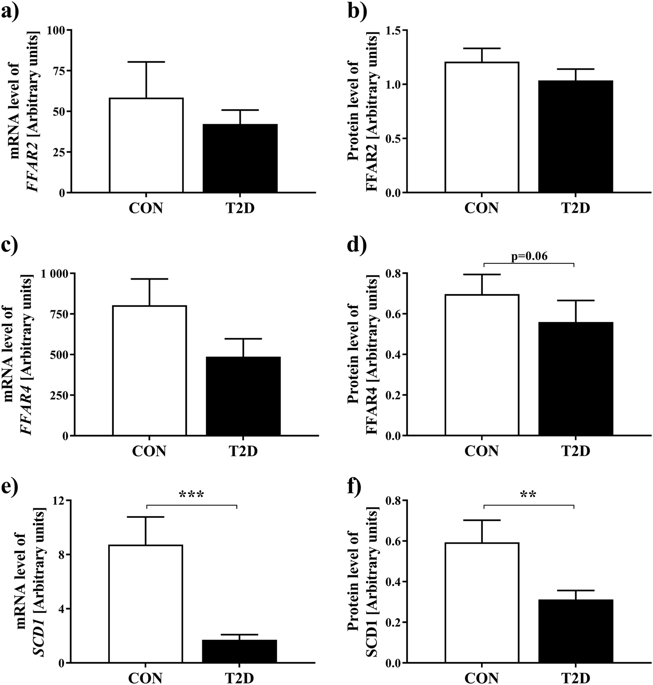Nutrition & Diabetes ( IF 4.6 ) Pub Date : 2018-09-07 , DOI: 10.1038/s41387-018-0054-9 Kálmán Bódis 1, 2 , Sabine Kahl 1, 2 , Marie-Christine Simon 1, 2 , Zhou Zhou 2, 3 , Henrike Sell 1, 2 , Birgit Knebel 2, 3 , Andrea Tura 4 , Klaus Strassburger 2, 5 , Volker Burkart 1, 2 , Karsten Müssig 1, 2, 6 , Daniel Markgraf 1, 2 , Hadi Al-Hasani 2, 3 , Julia Szendroedi 1, 2, 6 , Michael Roden 1, 2, 6 ,

|
Background
In subcutaneous adipose tissue (SAT), higher stearoyl-CoA desaturase-1 (SCD1) expression has been related to improved insulin sensitivity in thiazolidinedione-treated type 2 diabetes mellitus patients. In animal models, deficiency of the free fatty acid receptor (FFAR) 2 associated with higher and FFAR4-deficiency with lower insulin sensitivity. We hypothesized that increased FFAR2 expression and reductions in FFAR4 and SCD1 expression in SAT of type 2 diabetes mellitus patients associate positively with insulin resistance and impaired beta cell function.
Methods
Twenty-five type 2 diabetes mellitus patients and 25 glucose-tolerant humans (CON) matched for sex, age, and BMI underwent mixed-meal tests to assess insulin sensitivity (OGIS) and beta cell function (ΔAUC(C-peptide)0–180 min/ΔAUC(glucose)0–180 min) in a cross-sectional study. Gene and protein expression of SCD1 and FFAR2/4 were quantified in SAT biopsies.
Results
Insulin sensitivity was 14% and beta cell function 71% (both p < 0.001) lower in type 2 diabetes mellitus patients. In type 2 diabetes mellitus, SCD1 mRNA was fivefold (p < 0.001) and protein expression twofold (p < 0.01) lower. While FFAR2/4 mRNA and protein expression did not differ between groups, FFAR2 protein levels correlated negatively with beta cell function only in CON (r = −0.74, p < 0.01). However, neither SCD1 nor FFAR2/4 protein expression correlated with insulin sensitivity in both groups.
Conclusions
Type 2 diabetes patients have lower SCD1, which does not associate with insulin resistance. Only in non-diabetic humans, FFAR2 associated with impaired beta cell function.
中文翻译:

新诊断的 2 型糖尿病患者皮下脂肪组织中硬脂酰辅酶 A 去饱和酶 1 的表达降低,但游离脂肪酸受体 2 或 4 的表达降低
背景
在皮下脂肪组织 (SAT) 中,较高的硬脂酰辅酶 A 去饱和酶-1 ( SCD1 ) 表达与噻唑烷二酮治疗的 2 型糖尿病患者的胰岛素敏感性改善有关。在动物模型中,游离脂肪酸受体( FFAR ) 2 的缺乏与较高的胰岛素敏感性相关,而FFAR4 缺乏与较低的胰岛素敏感性相关。我们假设 2 型糖尿病患者 SAT 中 FFAR2 表达的增加和 FFAR4 和 SCD1 表达的减少与胰岛素抵抗和受损的 β 细胞功能呈正相关。
方法
25 名 2 型糖尿病患者和 25 名性别、年龄和 BMI 匹配的葡萄糖耐受者 (CON) 接受混合膳食测试以评估胰岛素敏感性 (OGIS) 和 β 细胞功能 (ΔAUC(C-肽) 0– 180 min /ΔAUC(glucose) 0–180 min ) 在横断面研究中。在 SAT 活检中量化 SCD1 和 FFAR2/4 的基因和蛋白质表达。
结果
2 型糖尿病患者的胰岛素敏感性降低 14%,β 细胞功能降低 71%(均p < 0.001)。在 2 型糖尿病中,SCD1 mRNA 是 5 倍 ( p < 0.001),蛋白质表达是低 2 倍 ( p < 0.01)。虽然 FFAR2/4 mRNA 和蛋白质表达在组间没有差异,但 FFAR2 蛋白质水平仅在 CON 中与 β 细胞功能呈负相关(r = -0.74,p < 0.01)。然而,SCD1 和 FFAR2/4 蛋白表达均与两组的胰岛素敏感性无关。
结论
2 型糖尿病患者的 SCD1 较低,这与胰岛素抵抗无关。仅在非糖尿病人中,FFAR2 与受损的 β 细胞功能相关。











































 京公网安备 11010802027423号
京公网安备 11010802027423号